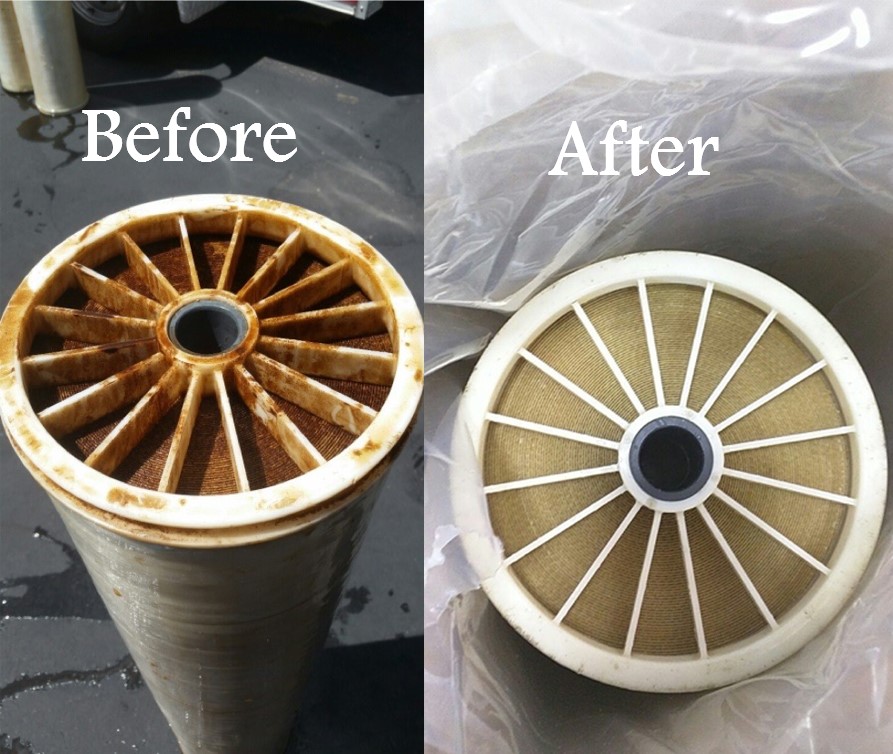How To Clean Reverse Osmosis (RO) Membranes
How To Clean Reverse Osmosis (RO) Membranes
Successful membrane cleaning relies on both the effectiveness of the cleaning compounds, their professional application and the design and operation of the cleaning equipment. For the best results, RO membrane cleaning should be performed with both high and low pH cleaning chemicals.
High pH RO Water Purifier Cleaning
The high pH Cleaning is performed in order to remove biological or organic foulants, both of which contain carboxylic functional groups. Weak acids will gain an anionic charge at the high pH allowing them to disperse. High pH cleaning chemicals chelate the calcium that bridges foulants and biofilms to each other and to the membrane surface. Commodities such as NaOH are only mildly effective because of their inability to remove the calcium bridging.
Low pH RO Water Purifier Cleaning
In some cases a low pH cleaning may be the better option prior to a high pH cleaning. However organic foulants can lose their anionic charge if a low pH cleaning is performed first and can end up being compacted into the membrane. To find out which option is best for your system Complete Water Solutions can evaluate your system, including performing a foulant analysis.
Perform RO Membrane Cleaning In Stages
Membrane cleaning results are best reached if each stage is cleaned individually. This will allow for the maximum flow velocity during cleaning. If both stages of a system with a 2:1 array are cleaned simultaneously, each pressure vessel in the second stage will receive twice the flow velocity as the first stage. This would in turn cause membrane telescoping in the second stage if the first stage elements are cleaned at optimal flow velocity. Alternately, by basing the flow velocity on the second stage, the first stage membranes would not receive sufficient surface scouring.
Chemical Cleaning RO Membranes - Step By Step Procedure
The following general chemical cleaning procedure can be followed, however, to determine the optimum cleaning procedure for your RO system, contact Complete Water Solutions at (855) 787-4200 today!
- Inspect cleaning tank, hoses, and cartridge filters. Clean tank and flush hoses if necessary. Install new cartridge filters.
- Fill the cleaning tank with RO permeate or DI water. Turn on the agitator or tank recirculation pump.
- Slowly add (your selected RO cleaning product) to the cleaning tank based on the CIP total volume and the product strength needed and allow it to mix thoroughly.
- Check solution temperature. If the solution temperature is lower than the recommended level, adjust heating control to provide the optimum temperature. If the manufacturer’s recommendation is not available, contact Complete Water Solutions.
- Check the pH of the solution. The pH should be <12 or as recommended by the membrane manufacturer. If pH is too low, adjust pH upward with sodium hydroxide (NaOH) or another chemical as recommended by the membrane manufacturer. If pH is too high, adjust with hydrochloric acid (H₂O:HCl).
- Circulate solution through one stage at a time in the direction of feed flow for 30 minutes. Circulate at the flow rate recommended by the membrane or system manufacturer. If the manufacturer’s recommendation is not available, contact Complete Water Solutions helpful staff. Pressure should be low enough so that minimal permeate is produced during cleaning, but always less than 60 psig [4.2kg/cm²].
- In cases of heavy fouling, the first return flow (up to 15% of the cleaning tank volume) be diverted to drain to prevent redeposition of removed solids. For optimum results, each stage must be cleaned separately in a multistage system.
- If the first stage cleaning solution becomes turbid or discolored, dump the tank and prepare a fresh cleaning solution before proceeding. If the solution pH or temperature moves out of the recommended range, a new solution should be prepared. In any event, a new cleaning solution should be prepared for each stage.
- Rinse with RO permeate before returning the system to service.
- When returning unit to service, divert product water to drain until any residual cleaning solution has been rinsed from the system.
Depending on the nature of the fouling, a soak period may be necessary for optimum results. Consult Complete Water Solutions for further details.


